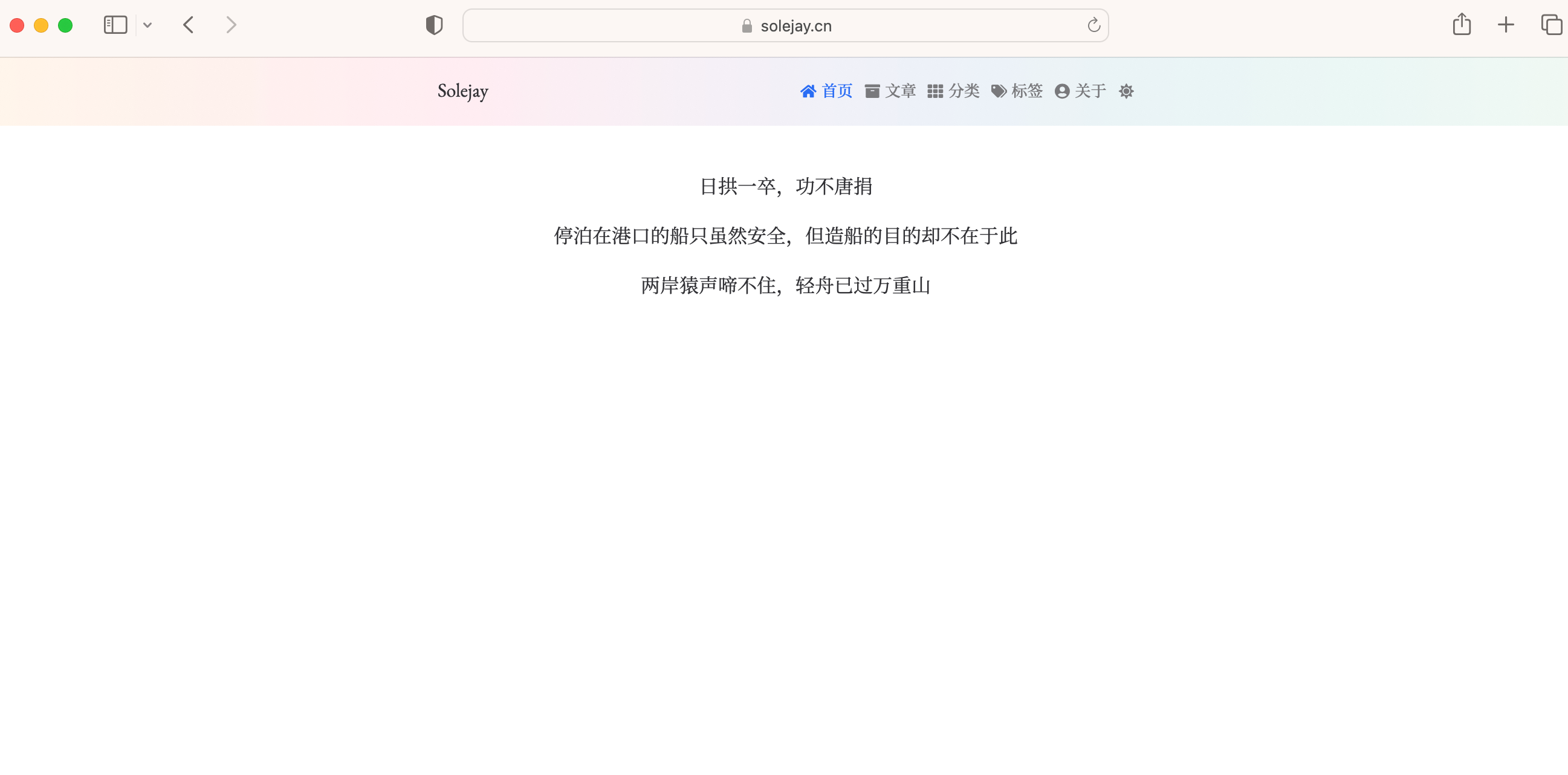Hugo博客搭建
Hugo 构建
Hugo 安装
- 下载 安装包
hugo version查看是否安装成功
生成站点基础框架
- 进入自己指定文件夹下执行
hugo new site solejay-blog - 创建仓库
cd solejay-blog
git init
主题配置
- 进入 Hugo 主题页面 选择主题并下载
个人喜欢的主题:meme、newsroom、galary、Alpha Church、Moments
# meme
# 下载主题
git submodule add --depth 1 https://github.com/reuixiy/hugo-theme-meme.git themes/meme
# 替换 toml 文件
rm config.toml && cp themes/meme/config-examples/en/config.toml config.toml
新建博客
hugo new posts/first-post.md
本地调试和打包构建
- 本地调试
hugo server -D
即可在本地 http://localhost:1313/ 看到静态页面
- 打包构建
调试没有问题运行 hugo 在当前目录下生成 public 子目录
Github 部署
1. 新建 Github Pages 仓库
仓库用来存放生成的静态页面
仓库名称:username.github.io
需要保证有一个分支,通过本地推送一个 master 分支
git clone git@github.com:username/username.github.io.git
username 替换为自己的用户名
-
touch .gitignore -
git add . -
git commit -m "first commit" -
git push --set-upstream origin master
2. 生成 GITHUB ACTION token
-
网页版,点击头像,进入 Github 个人的 Settings:
-
边栏最下方 Developer Settings,
-
选择 Personal access tokens 下的 Tokens (classic)
点击右方 Generate a new token (classic) -
输入密码后进入设置,在 Note 框中填写方便识别的名字,如 Deploy,有效期(Expiration)建议选择永不过期(No expiration),访问范围(Scopes)我们需要选中 repo 和 workflow
-
点击生成后 token 即出现,注意它只会出现这唯一的一次,将其复制保存下来
3. 新建博客仓库
仓库用来写博文,执行 Github Actions 自动构建静态页面推送到上面的 Github Pages 仓库中
-
git clone git@github.com:username/blog.git -
vim .gitignore
忽略那些无关的文件,和生成的静态文件
.DS_Store
/public
.hugo_build.lock
resources/_gen/assets/scss
-
git add . & git commit -m "first commit" -
git push --set-upstream origin master -
进入仓库的 Settings
-
选择 Secrets and variables 下的 Actions,在右侧选择 New repository secret
-
在 Name 中填入 PERSONAL_TOKEN
-
在 Secret 中填入刚才生成的 token
-
点击 Add secret 保存
4. 配置 Github Actions
-
进入仓库的 Actions,若之前有使用过,点击左侧 New workflow;若无,默认会给出许多推荐,我们任选一个开始 configure 即可:
-
重命名 .yml 为方便识别的名字,如 deploy.yml
修改编辑框内容如下:
name: deploy
# 这个 action 的名字on:push: # 代表每次 push 都会 turn on actionworkflow_dispatch: # 代表我们也可以手动 turn onjobs:build:runs-on: ubuntu-lateststeps:- name: checkoutuses: actions/checkout@v2with:submodules: truefetch-depth: 0- name: setupuses: peaceiris/actions-hugo@v2.6.0with:hugo-version: "latest"extended: true # 按需选择是否使用 hugo-extended- name: buildrun: hugo -D- name: deployuses: peaceiris/actions-gh-pages@v3with:# 生成的 token 就用在这里,因为下面用到 external repositoryPERSONAL_TOKEN: ${{ secrets.PERSONAL_TOKEN }} # 替换为新建 Github Pages 仓库中的仓库名称EXTERNAL_REPOSITORY: username/username.github.io# 以及对应的分支 masterPUBLISH_BRANCH: master # 指定将自动部署得到的 public 文件夹 push 上去PUBLISH_DIR: ./public # 提交信息commit_message: ${{ github.event.head_commit.message }}
-
点击左上角 Save new workflow,保存配置文件并提交,自动触发构建
-
构建成功即可访问对应仓库的 Github Pages 地址
https://purenjie.github.io/
5. 后续更新
后续只需要在 blog 仓库中更新博文,然后 push 即可触发 Github Actions 自动构建并推送到 Github Pages 仓库中
Gitee 部署
Gitee 已经无法使用 Pages,不建议使用
- 新建仓库
添加一个空白 repository,注意不要添加如 README,.gitignore 等文档。仓库名最好与个人空间地址一致
推送项目到 master 分支
- 进入 Gitee 创建的仓库页面,从
服务栏里选择Gitee Pages,部署分支选择master,然后点击启动
服务器部署
-
保证 80 端口和 443 端口没有被禁用(可查看防火墙策略)
-
安装并启动 nginx
# 安装
sudo yum install -y nginx# 设置开机启动
sudo systemctl enable nginx# 启动
sudo systemctl start nginx# 浏览器访问公网 IP 查看是否安装成功
- 将 public 目录传输到服务器
# 创建同步目录
mkdir /home/solejay/blog# 使用 rsync 方式同步
cd BLOG_FOLDER # 本地
rsync -avuz --progress --delete public/ root@ip 地址:/home/solejay/blog
- 申请 ssl 证书
- 申请免费证书
- 下载 nginx 证书
- 将证书上传到服务器
rsync -avuz --progress Nginx/ root@ip 地址:/etc/nginx/
- 配置 nginx.conf
# For more information on configuration, see:
# * Official English Documentation: http://nginx.org/en/docs/
# * Official Russian Documentation: http://nginx.org/ru/docs/user root;
#user nginx;
worker_processes auto;
error_log /var/log/nginx/error.log;
pid /run/nginx.pid;# Load dynamic modules. See /usr/share/doc/nginx/README.dynamic.
include /usr/share/nginx/modules/*.conf;events {worker_connections 1024;
}http {log_format main '$remote_addr - $remote_user [$time_local] "$request" ''$status $body_bytes_sent "$http_referer" ''"$http_user_agent" "$http_x_forwarded_for"';access_log /var/log/nginx/access.log main;sendfile on;tcp_nopush on;tcp_nodelay on;keepalive_timeout 65;types_hash_max_size 2048;include /etc/nginx/mime.types;default_type application/octet-stream;# Load modular configuration files from the /etc/nginx/conf.d directory.# See http://nginx.org/en/docs/ngx_core_module.html#include# for more information.include /etc/nginx/conf.d/*.conf;server {listen 80 default_server;listen [::]:80 default_server;server_name _;#root /usr/share/nginx/html;root /home/solejay/blog;# Load configuration files for the default server block.include /etc/nginx/default.d/*.conf;location / {root /home/solejay/blog;index index.html index.htm;}error_page 404 /404.html;location = /40x.html {root /home/solejay/blog;}error_page 500 502 503 504 /50x.html;location = /50x.html {}}# 配置 httpsserver {listen 443 ssl;# 要配置的第七个地方server_name _;root /home/solejay/blog;# 要配置的第八个地方ssl_certificate /etc/nginx/solejay.cn_nginx/solejay.cn_bundle.crt;ssl_certificate_key /etc/nginx/solejay.cn_nginx/solejay.cn.key;# 要配置的第九个地方,可以按照我的写法ssl_session_timeout 10m;ssl_protocols TLSv1 TLSv1.1 TLSv1.2;ssl_ciphers ECDHE-RSA-AES128-GCM-SHA256:HIGH:!aNULL:!MD5:!RC4:!DHE;ssl_prefer_server_ciphers on;# 要配置的第十个地方error_page 404 /404.html;location = /404.html {root /home/solejay/blog;}include /etc/nginx/default.d/*.conf;}
}
- 重新加载配置文件并重启
# 重新加载配置文件
sudo nginx -s reload# 重启 nginx
sudo systemctl restart nginx
- https 访问域名成功

** 参考资料 **
Hugo+Gitee 搭建个人博客
如何使用 Hugo 在 GitHub Pages 上搭建免费个人网站
hugo 博客部署到腾讯云轻量级服务器
使用 Github Actions 自动部署 Hugo
